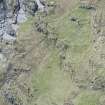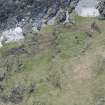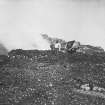Scheduled Maintenance
Please be advised that this website will undergo scheduled maintenance on the following dates: •
Tuesday 3rd December 11:00-15:00
During these times, some services may be temporarily unavailable. We apologise for any inconvenience this may cause.
Tiree, Ceann A' Mhara
Kelp Kiln(S) (Post Medieval), Kelp Working Site (Post Medieval), Wall (Post Medieval)
Site Name Tiree, Ceann A' Mhara
Classification Kelp Kiln(S) (Post Medieval), Kelp Working Site (Post Medieval), Wall (Post Medieval)
Alternative Name(s) Kenavara; Kenamara; Balephuil Bay
Canmore ID 21475
Site Number NL94SW 13
NGR NL 9394 4034
Datum OSGB36 - NGR
Permalink http://canmore.org.uk/site/21475
- Council Argyll And Bute
- Parish Tiree
- Former Region Strathclyde
- Former District Argyll And Bute
- Former County Argyll
NL94SW 13 939 403.
Kelp-burning Kilns. A group of these structures is situated above high-water mark on the storm-beach of the rocky W shore of Balephuil Bay. A specimen kiln was found to be of elongated rectangular plan, and consisted simply of a shallow pit open at one end and enclosed on the other three sides by low cobble walls of rough dry-stone construction. The pit or kiln-chamber, which was also floored with loose cobbles, measured 4.4m in length by o.6m in width within walls having an average thickness of 0.6m and a height of about 0.5m. These measurements are consistent with the dimensions of kilns of rectilinear plan described in a late-18th century treatise on kelp manufacture.
Production of kelp on Tiree had ceased by 1837. A kelp manufactory at Middleton (NL 942 433), now in ruins, was later built in an attempt to revive the industry on the island.
RCAHMS 1980, visited 1974.
Scheduled as Balephuil Bay, kelp kilns, Tiree.
Information from Historic Scotland, scheduling document dated 14 January 2002.
This site has only been partially upgraded for SCRAN. For further information, please consult the Architecture Catalogues for Argyll and Bute District..
February 1998
Field Visit (June 1974)
Kelp-burning Kilns, Ceann a' Mhara, Tiree.
The remains of small kelp-burning kilns occur in a number of places round the shores of Tiree, and a typical group of these structures is situated above high-watermark on the storm-beach of the rocky W shore of Balephuil Bay. A specimen kiln was found to be of elongated rectangular plan, and consisted simply of a shallow pit open at one end and enclosed on the other three sides by low cobble walls of rough dry-stone construction. The pit or kiln-chamber, which was also floored with loose cobbles, measured 4.4 m in length by 0.6 m in width within walls having an average thickness of 0.6 m and a height of about 0.5 m.
These measurements are consistent with the dimensions of kilns of rectilinear plan described in a late-18th century treatise on kelp manufacture (en.1). The manufacture of kelp was introduced into Tiree in 1746 and reached its peak of prosperity during the period of the Napoleonic Wars (en.2). Following the reduction of duties on imported sources of alkali and the abolition of the salt tax in 1825, there was a rapid decline in the kelp-making industry and, according to the author of the second Statistical Account (en.3), production of kelp on Tiree had ceased by 1837. A kelp manufactory at Middleton (NL 942 433), now in ruins, was later built in an attempt to revive the industry on the island.
RCAHMS 1980, visited June 1974
En.1: Mackenzie, H (ed.), Prize Essays and Transactions of the Highland Society of Scotland, i (1799), 35-9; for kelp-burning kilns of circular plan, cf. ibid., 15-16.
En.2: Ibid., 4; Cregeen, Estate Instructions, passim.
En.3: NSA, vii (Argyll), 216


























































